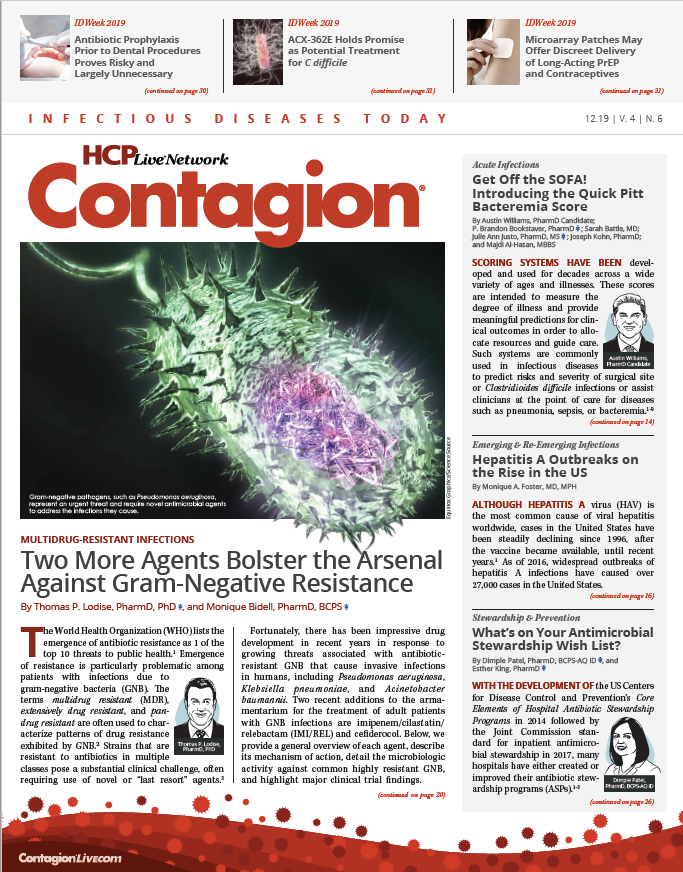The Year Ends With a Big Step in PrEP and PEP
Something novel in infectious diseases practice has occurred and, like many big changes, it is not without controversy.
Something novel in infectious diseases practice has occurred and, like many big changes, it is not without controversy. In October, Gov Gavin Newsom of California signed SB 159 into law.1 This legislation allows pharmacists to dispense up to a 60-day supply of antiretrovirals for either pre-exposure prophylaxis (PrEP) or post-exposure prophylaxis (PEP) without a prescription, provided certain conditions are met. The law goes into effect in July.
Some conditions include limiting the supply of the drug to 60 days, requiring dispensing pharmacists to complete an approved education program, documenting a negative HIV test or negative in-pharmacy HIV test at the time of dispensing (waived for PEP), and notifying the patient’s primary care physician. It also requires the state Medicaid program, Medi-Cal, to cover the cost of the medication and forbids commercial insurance from requiring preau­thorization for dispensing.
Some controversy followed SB 159 as it made its way through the legislature, which led to some of those conditions. I first learned of the proposed law in March, when I attended a conference of the Infectious Diseases Association of California. During an open forum about the bill, pharmacist attendees expressed concerns about patients falling into and out of care without follow-up and the potential for busy pharmacists in community settings to assume responsibilities for which they are not ready.
I was shocked by that response, which I believe missed the bigger picture: the need to expand access to therapies that lower the number of patients who contract HIV. It can help unburden emergency departments, where patients typically seek out PEP.
That response also ignores the fact that pharmacists are a generally conservative group and, as a profession, reluctant to become involved in areas in which they are uncomfortable. One of the great untapped resources of clinical expertise in 21st-century medicine is the training of doctors of pharmacy, in which curricula long ago moved from focusing on the basic sciences of pharmacology to clinical sciences of pharmacotherapy. Taking advantage of the broad accessibility of community pharmacists to expand the reach of therapies proven to prevent HIV infection is a no-brainer.
This law has enormous potential beyond California. Uptake of PrEP increased by a year-over-year average of 73% from 2012 to 2016 but is still used by less than 10% of people who are at high risk of HIV infection. The changes made to California’s pharmacy practice act are clear-cut and straightforward. These can be easily replicated by other states where access to PrEP is even more essential.
Use of and access to PrEP is already uneven. In 2016, just 5 states accounted for nearly half of all PrEP use: California, New York, Florida, Texas, and Illinois. Although each of these states has room for improved PrEP use, the biggest need is probably in the South, where over half of new HIV diagnoses occurred in 2016. Further, uptake of PrEP is unsurprisingly related to access to health care, because it is more commonly used in states that expanded Medicaid under the Affordable Care Act.2
The United States has set a goal of reducing HIV by 90% by 2030, and the plan relies heavily on prophylaxis.3 Improved access to PrEP is key to realizing this ambition, and California found a way to open to door to preventive therapy a little bit wider.
Our feature article this month—by Thomas P. Lodise, PharmD, PhD, and Monique Bidell, PharmD—discusses 2 new agents for the treatment of adult patients with highly resistant gram-negative infections: imipenem/cilastatin/relebactam and cefiderocol.
As always, enjoy this issue, and keep up with us at ContagionLive.com.
Gallagher is a clinical professor at Temple University School of Pharmacy and clinical pharmacy specialist in infectious diseases at Temple University Hospital, both in Philadelphia, Pennsylvania. He is also the director of the PGY2 Residency in Infectious Diseases Pharmacy at Temple.
References:
- HIV Preexposure and Postexposure Prophylaxis, SB-159, California Senate (2019). https://leginfo.legislature.ca.gov/faces/billTextClient.xhtml?bill_id=201920200SB159
- Siegler AJ, Mouhanna F, Giler RM, et al. The prevalence of pre-exposure prophylaxis use and the pre-exposure prophylaxis-to-need ratio in the fourth quarter of 2017, United States. Ann Epidemiol. 2018 Dec;28(12):841-9. doi: 10.1016/j.annepidem.2018.06.005.
- US Department of Health and Human Services. What is ‘Ending the HIV Epidemic: A Plan for America’?. HIV.gov website. https://www.hiv.gov/federal-response/ending-the-hiv-epidemic/overview

